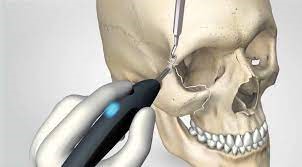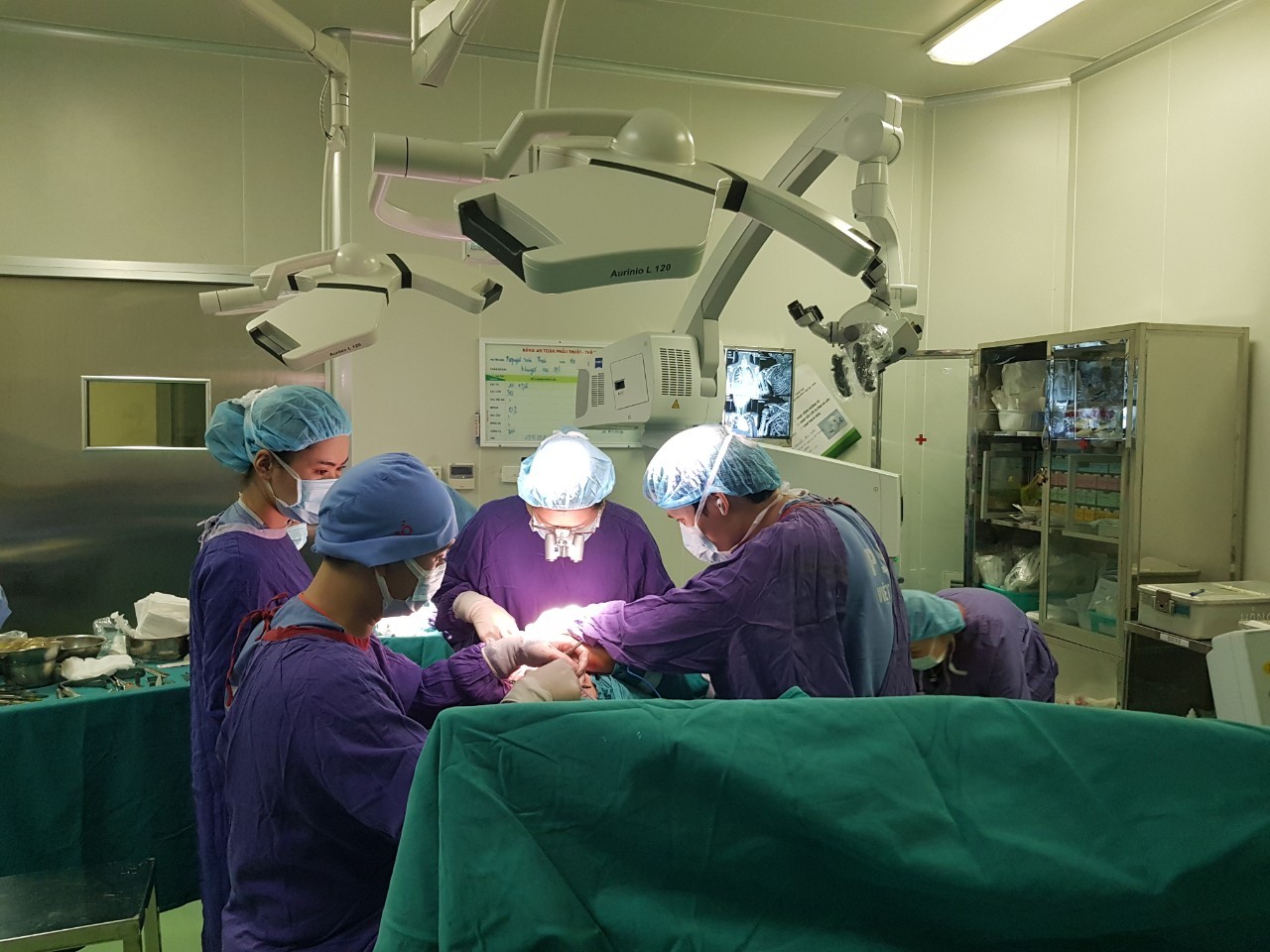Usefulness of Ultrasound-Aided Fixation Using an Absorbable screw for treating successfully many cases of craniosynostosis
25/08/2021 11:10
Looking at two siblings N.Q.A, 7 years old and N.T.K, 20 months old playing happily with their parents, few people can imagine that just a short while ago, the two siblings had to undergo surgery to reconstruct their skulls due to craniosynostosis.
Mr. N.T.T, their father, shared that since they were born until now, his two children have not shown any obvious signs of underdevelopment compared with other children of the same age. Only the older sister, the older she got, the bigger and more bulging her eyes became. Her skull was also slightly deformed compared to normal. The family took her to get an examination at the Department of Maxillofacial, Plastic and Aesthetic Surgery, Viet Duc University Hospital (VDUH), where she was diagnosed with craniosynostosis. At that time, when consulting the doctors about N.Q.A’s disease, the parents were startled when they realized that N.Q.A’s younger brother also had similar symptoms. They rushed him to the hospital. The doctors also diagnosed him with craniosynostosis at coronal joint on one side. After consulting the children, the doctors have planned two skull reconstruction surgeries at the Department of Maxillofacial, Plastic and Aesthetic Surgery, VDUH, 5 months apart with the use of modern technologies in diagnosis and treatment. Finally, like the sweet fruits obtained after many hours of hopes and worries from the family, the success of the operations helped two children returning to life like any other normal children and N.Q.A is now able to return to class with her teachers and friends.

Illustration of a skull that expands well under the effect of plate system
According to Nguyen Hong Ha, PhD, Assoc. Prof – Head of the Department of Maxillofacial, Plastic and Aesthetic Surgery, VDUH: Craniosynostosis is a congenital abnormality in which one or more cranial sutures is closed prematurely. The overall prevalence has been estimated at 1 in 2000 births, this may occur separately or in association with other congenital anomalies in severe syndromes such as Apert, Crouzon, Pfeiffer…
The premature closure of the cranial sutures rendered the skull unable to expand when the child grew up. Therefore, the intracranial pressure (ICP) increases and the brain cannot develop, especially in the first 12 months of the child’s life, which is the period when the child’s brain needs to develop very quickly. Increased ICP will cause brain compression. If surgery to expand the skull is not performed, the brain will not develop, leading to serious consequences that the child will be intellectually retarded and unable to take care of himself or herself instead of developing intellect in a normal way. The child’s eyes will increasingly be pushed out of the sockets and the part not covered is at risk of corneal ulcer, eventually leading to visual impairment and blindness. Therefore, early detection, diagnosis and surgical intervention of craniosynostosis is an urgent issue.
Dr. To Tuan Linh, Department of Maxillofacial, Plastic and Aesthetic Surgery added that in order to successfully treat the complex cases of craniosynostosis, in addition to the close coordination of a multidisciplinary team including surgeons, anesthesiologists, resuscitation and rehabilitation specialists, the application of up-to-date and modern technology for surgery is indispensable. Currently, VDUH routinely apply bio-absorbable polymer screws and plates (Poly – D,L – lactic acid – PDLLA) which are welded and screwed on using Sonic ultrasound during surgery.
In the past, when there was no multi-row absorbable plates system, to expand the skull, surgeons had to mainly use non – absorbable titanium screws and plates combined with steel thread or Vicryl thread. Thus, the skull is not optimally expanded and after 6 months to 1 year, the surgeons have to reopen the old scars to remove the entire non – absorbable screws and plates system from the body. Each such major surgery always harbors many potential risks for these children. Moreover, old generations of absorbable screws and plates often have weak bearing, if the force exerted to screw them on is too strong, the screws will break, so they are not widely used. Thanks to the ultrasound – aided fixation technology using the new generation of the absorbable screw and plate, the SonicPin absorbable screw is inserted into an ultrasonic priming hole and melted, which help the screws penetrate and firmly connect to the bone’s porous structure. As a result, the single – row as well as double – row screw and plate systems are firmly attached to the bone. The application of absorbable material can help reduce the implantation process time to half of that compared to fracture fixation method using conventional screw and plate. The successful application of ultrasound – aided absorbable screw and plate system fixation technology opens up great prospect not only for pediatric patients with craniosynostosis but also for other common orthognathic surgery or maxillofacial trauma cases.

Sonic ultrasound-aided absorbable screw and plate fixation system

Firmly screwed on thanks to Sonic ultrasound-aided absorbable screw and plate fixation technology
Vietnam is located in Southeast Asia, one of the areas with the highest rates of congenital craniofacial abnormality in the world. Therefore, the development of a medical team with high knowledge and skills along with the application of the most modern technologies in the treatment of patients with craniosynostosis is an urgent requirement. In recent years, VDUH has sent many doctors abroad to be trained at major centers of craniafacial surgery in the UK, France, USA, Canada… These doctors are full of speciaties such as Maxillofacial and plastic surgery, Anesthesiology, Neurosurgery… to build a synchronous team of experienced and highly skilled specialists in the treatment of these complex malformations.
Mr.Nguyen Hong Ha, PhD, Assoc.Prof added that thanks to the focus on training and technology transfer in cooperation with the world’s leading experts, as well as the investment of the Board of Directors of VDUH in modern equipment in diagnosis and treatment. Therefore, it can be said that the qualification and skill of our doctors are not inferior to the major craniofacial centers in the area and the world at large. In the last 2 years, due to the COVID-19 epidemic, families having children with severe complex craniofacial abnormalities have also decided to let their children to be operated in Vietnam, obtaining the same results as abroad. The pediatric patients are still treated with new and modern technologies on par with the world but the cost is much reduced. When there is any doubt about a child’s craniofacial abnormality, parents can rest assured taking their child to the Department of Maxillofacial, Plastic and Aesthetic Surgery, VDUH for having the best advice and treatment.

A craniofacial surgery case with the application of the most modern technology at Hanoi Viet Duc Hospital











